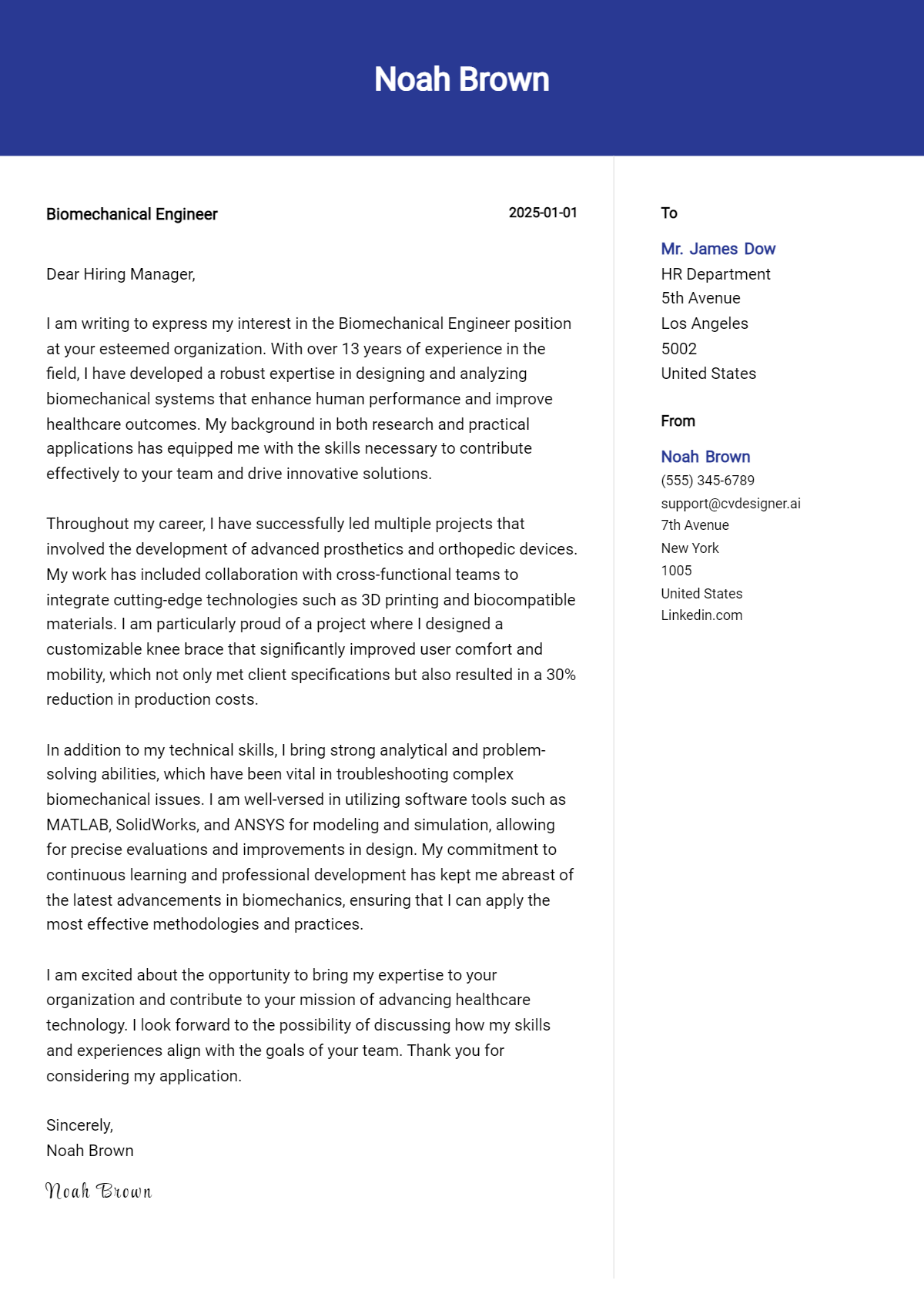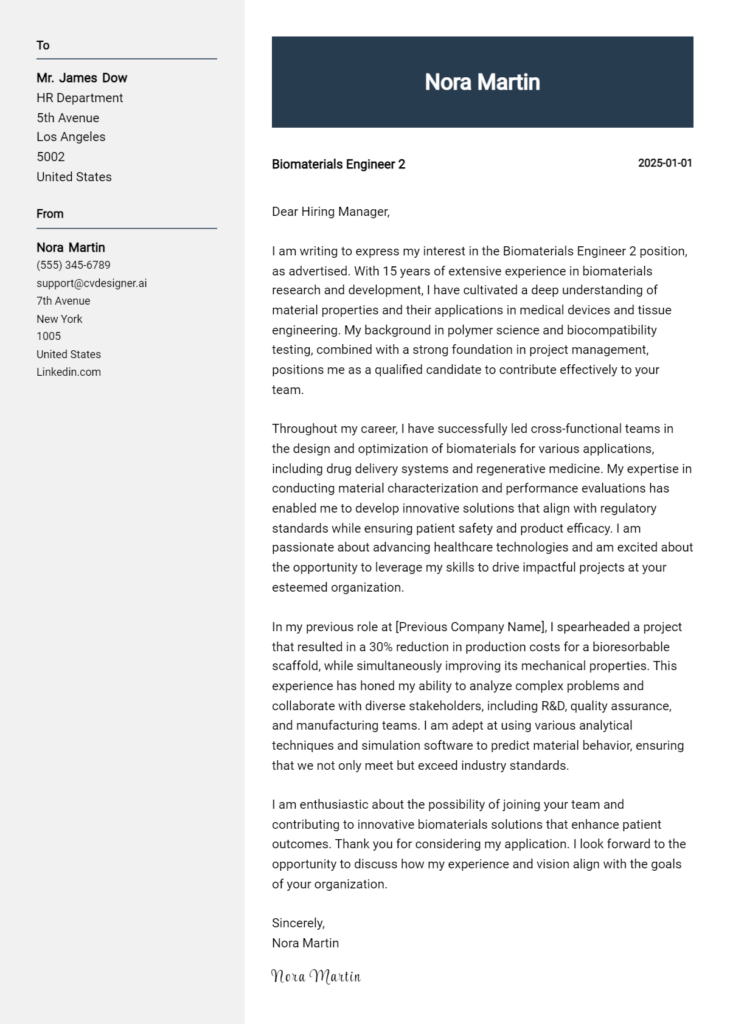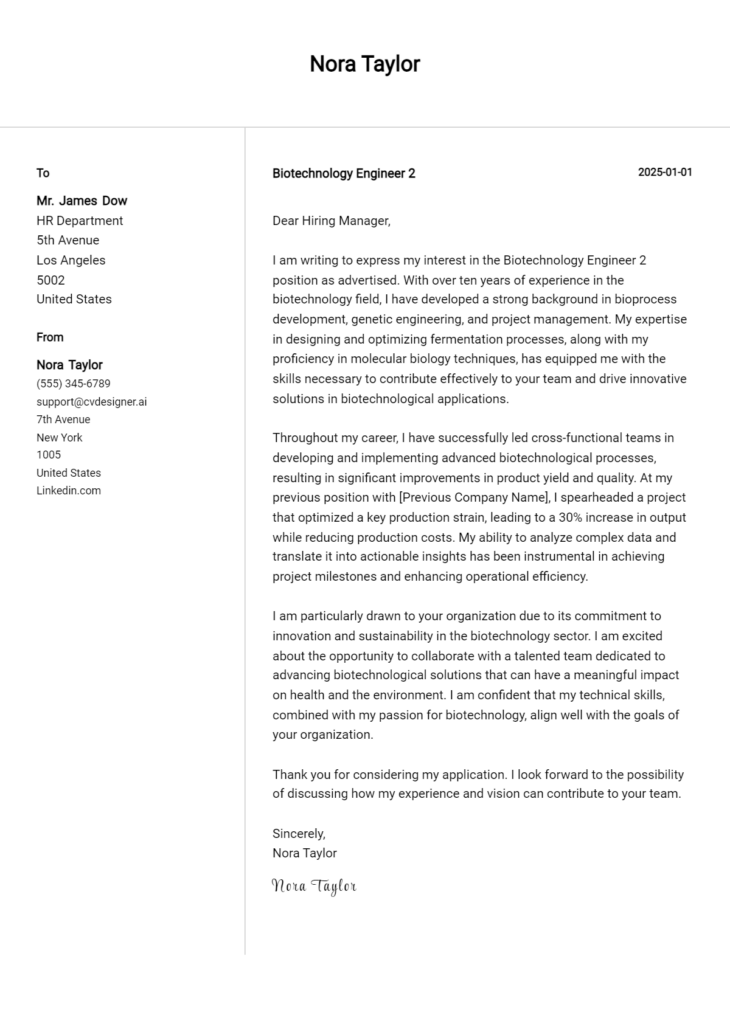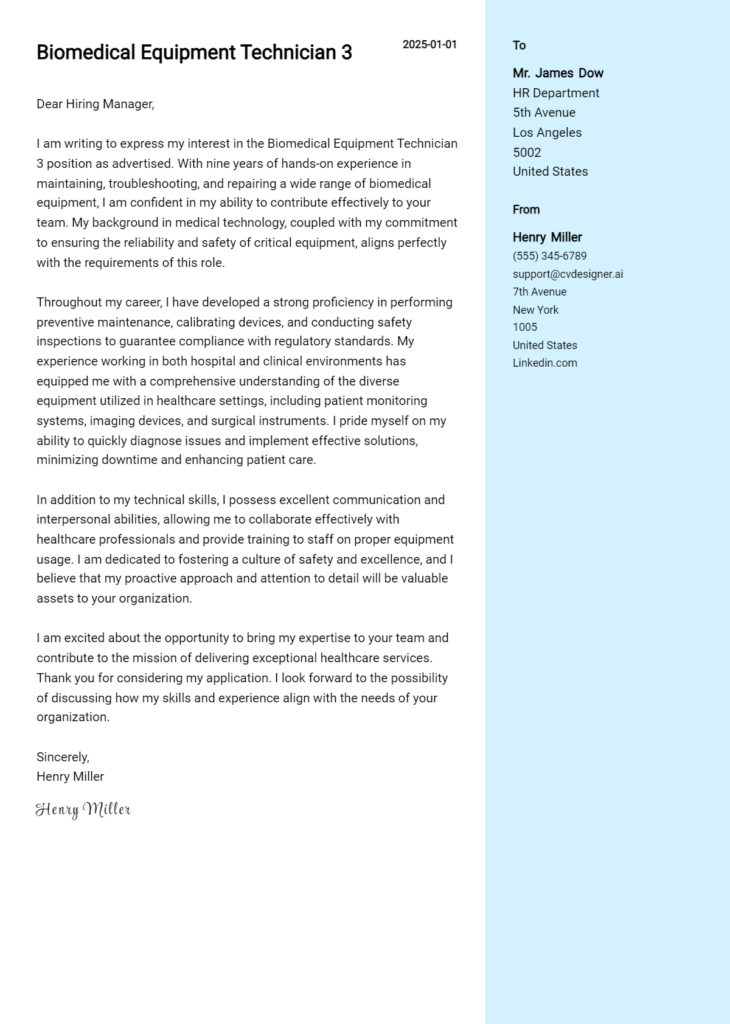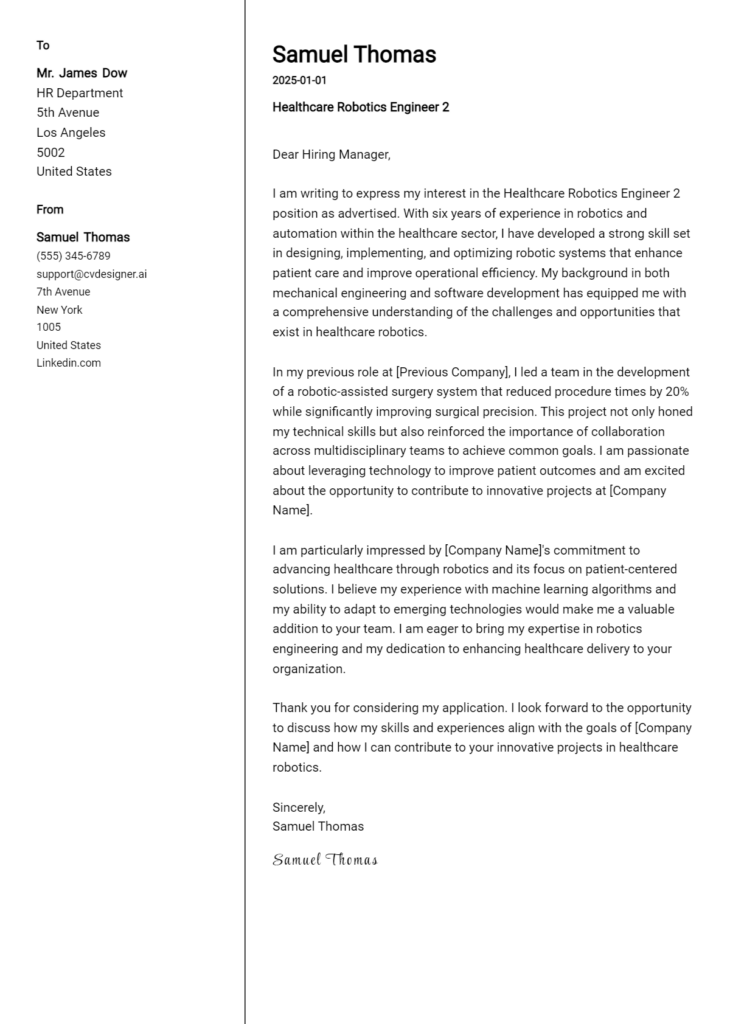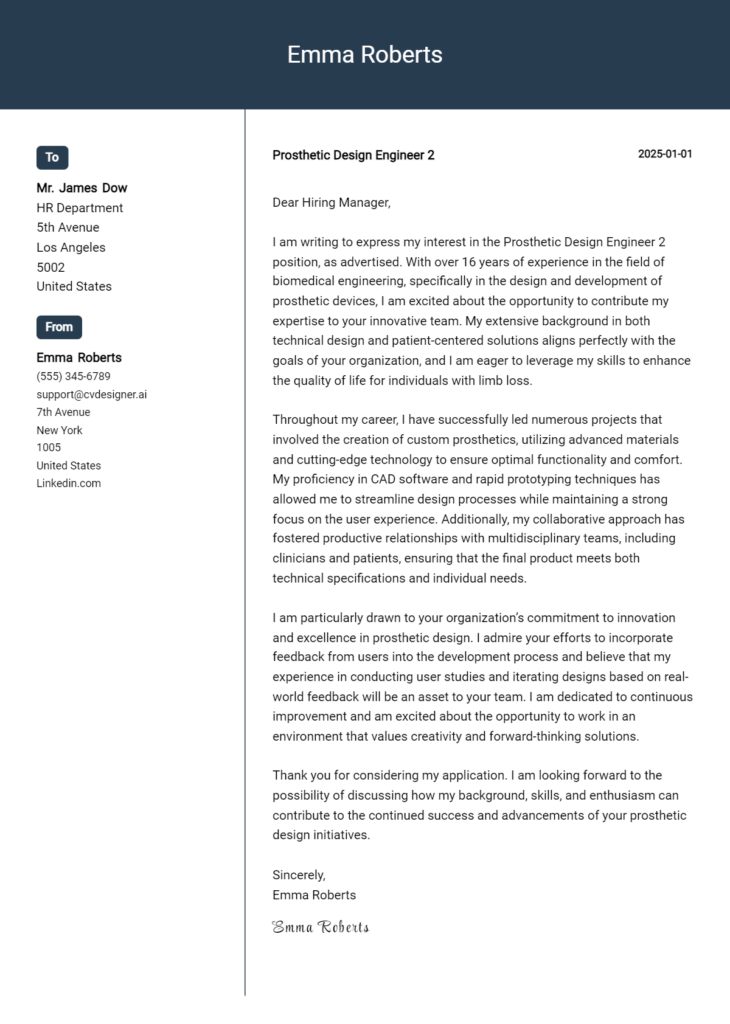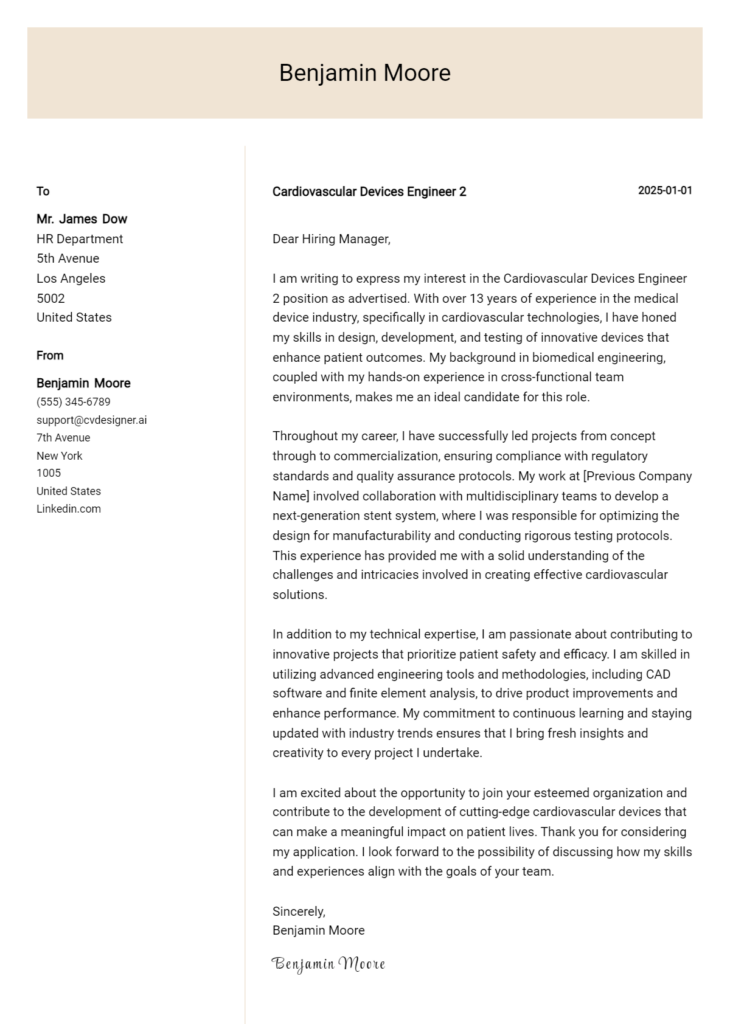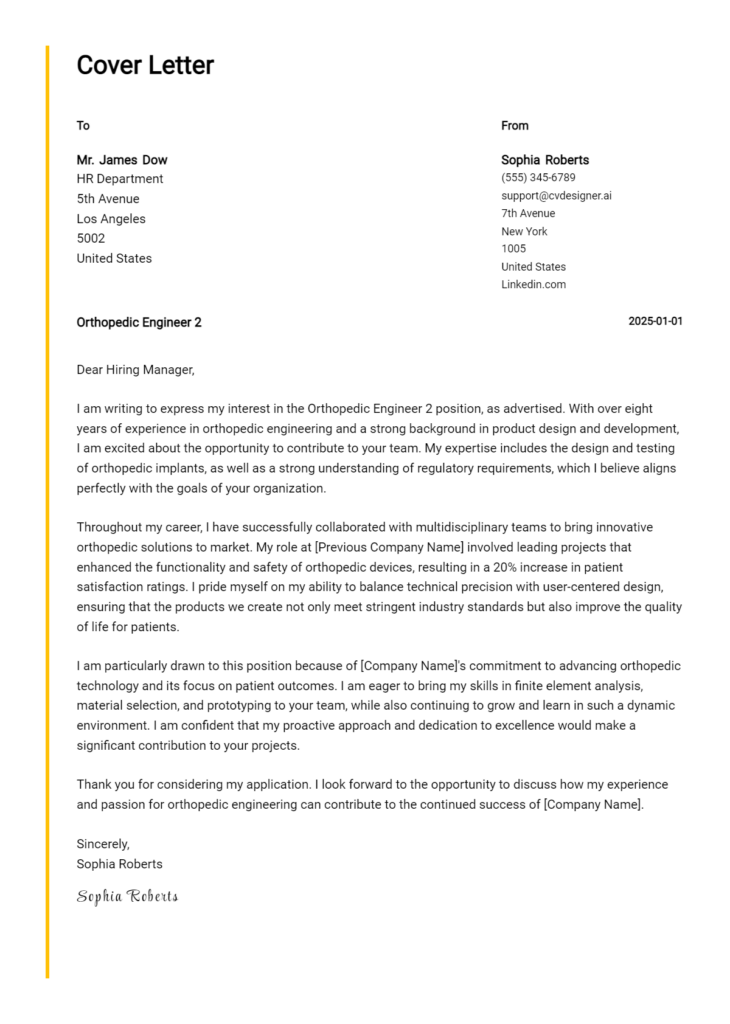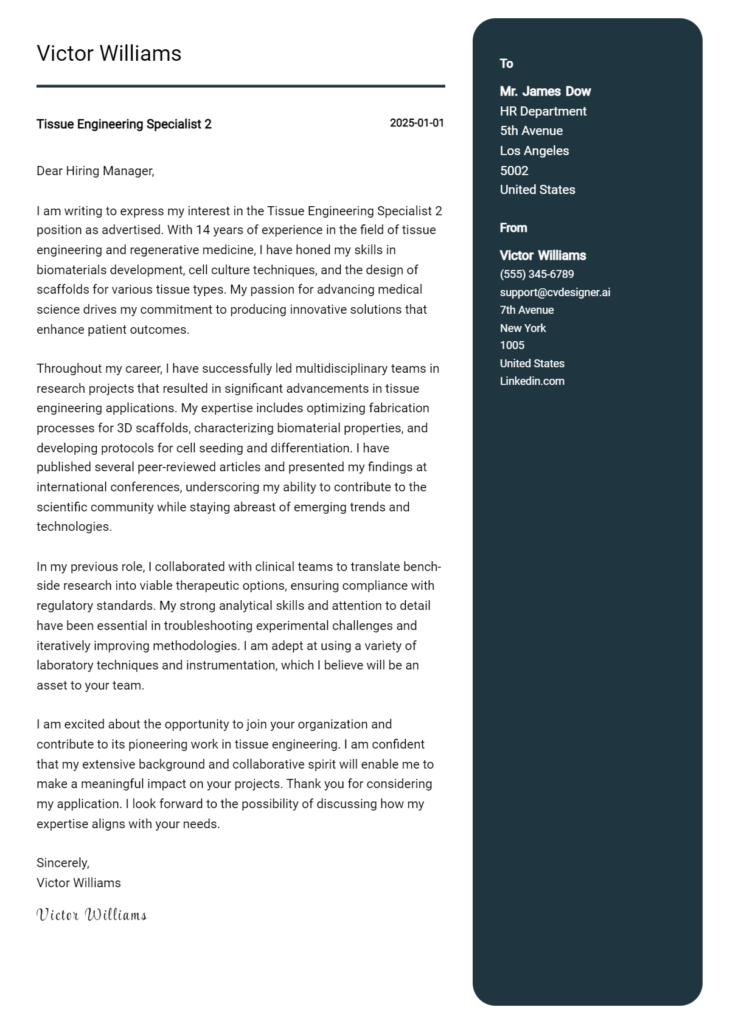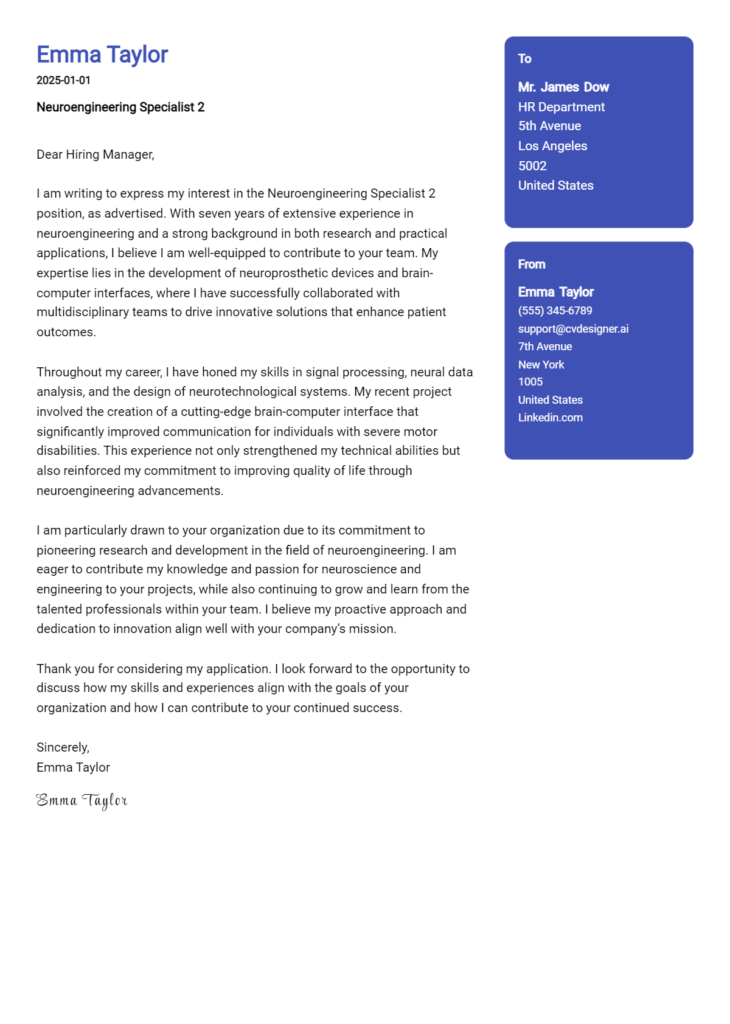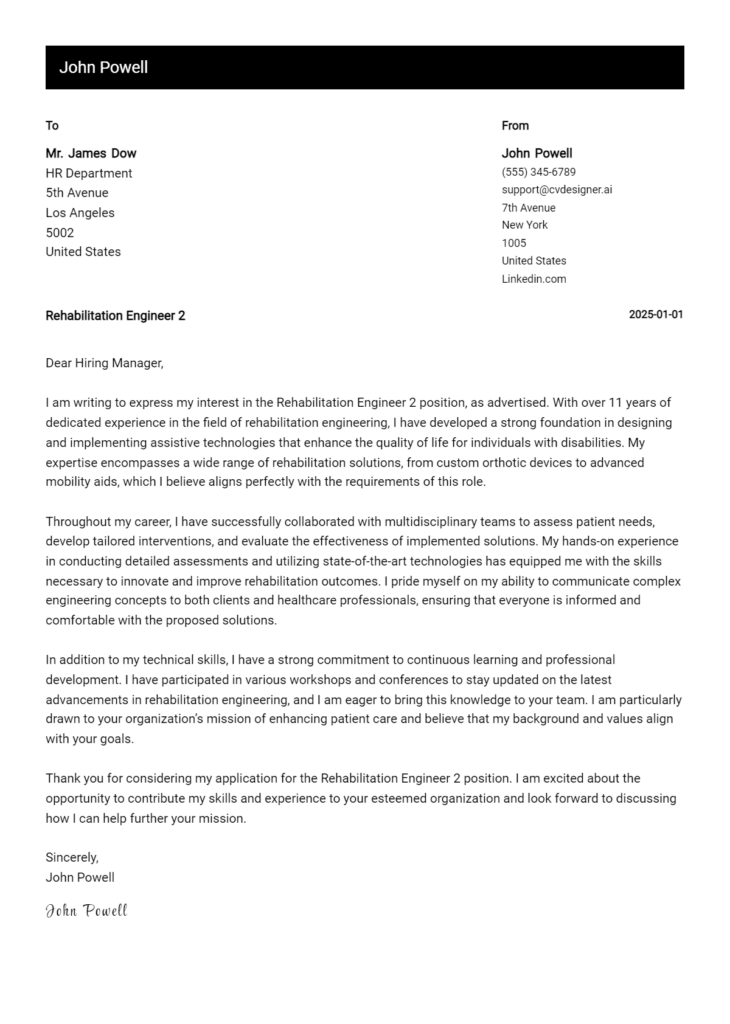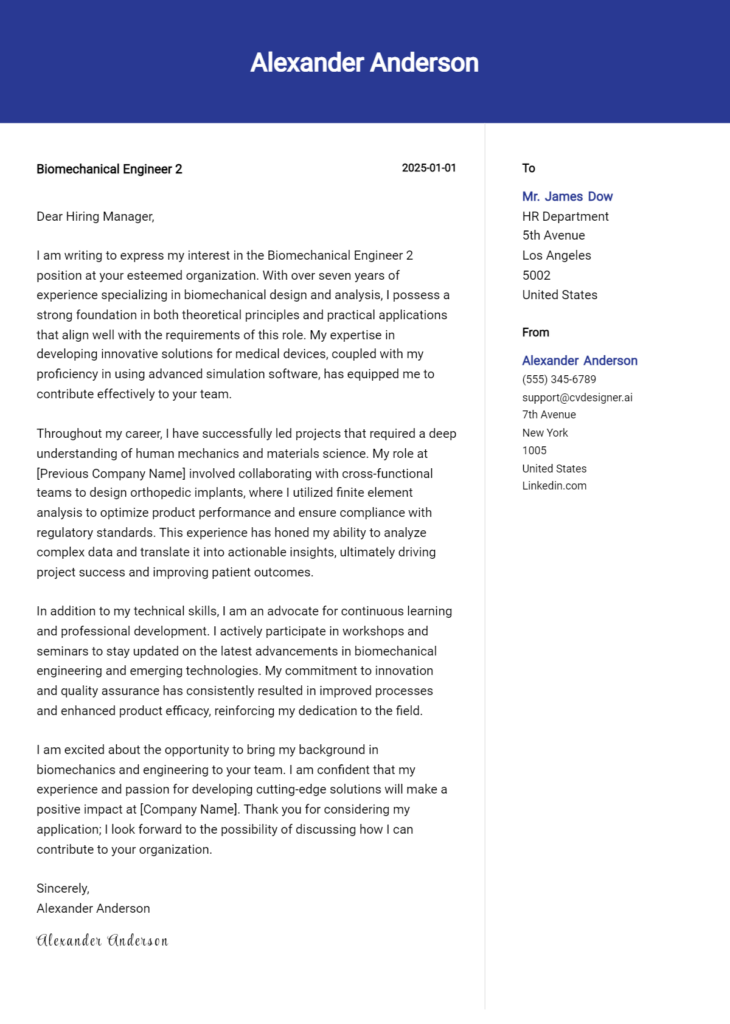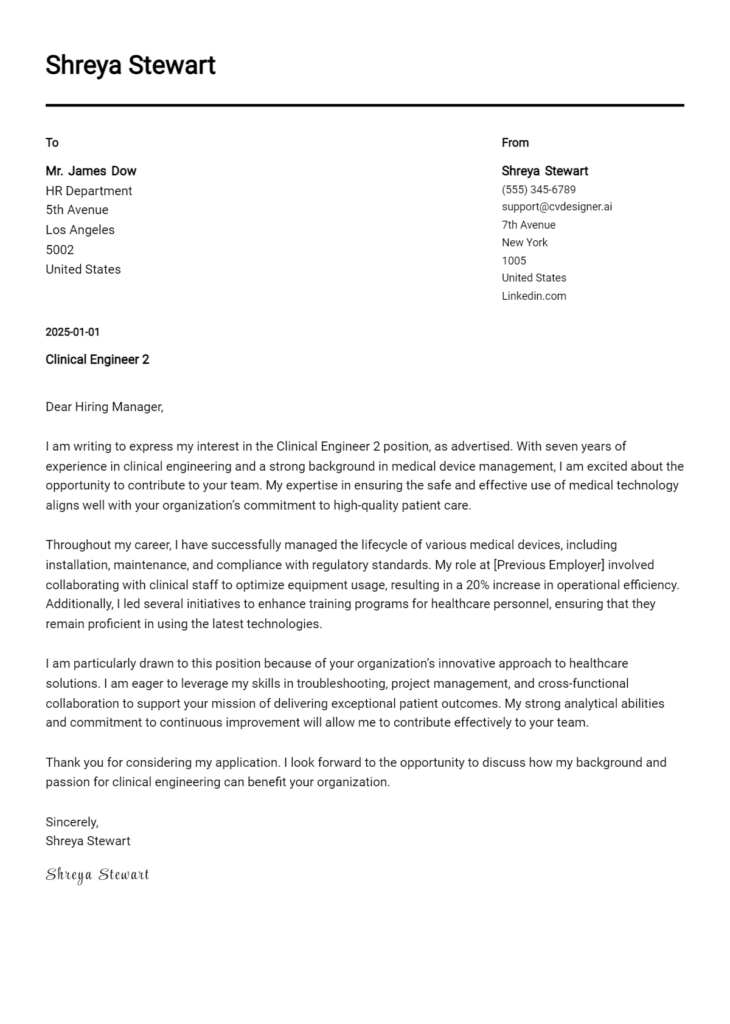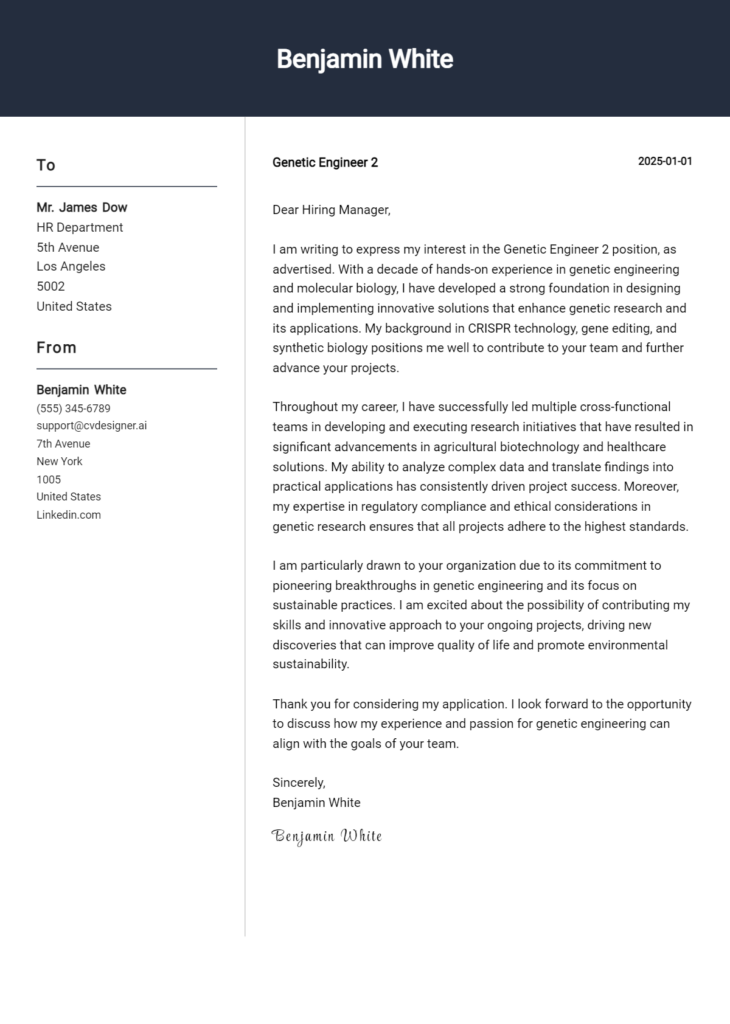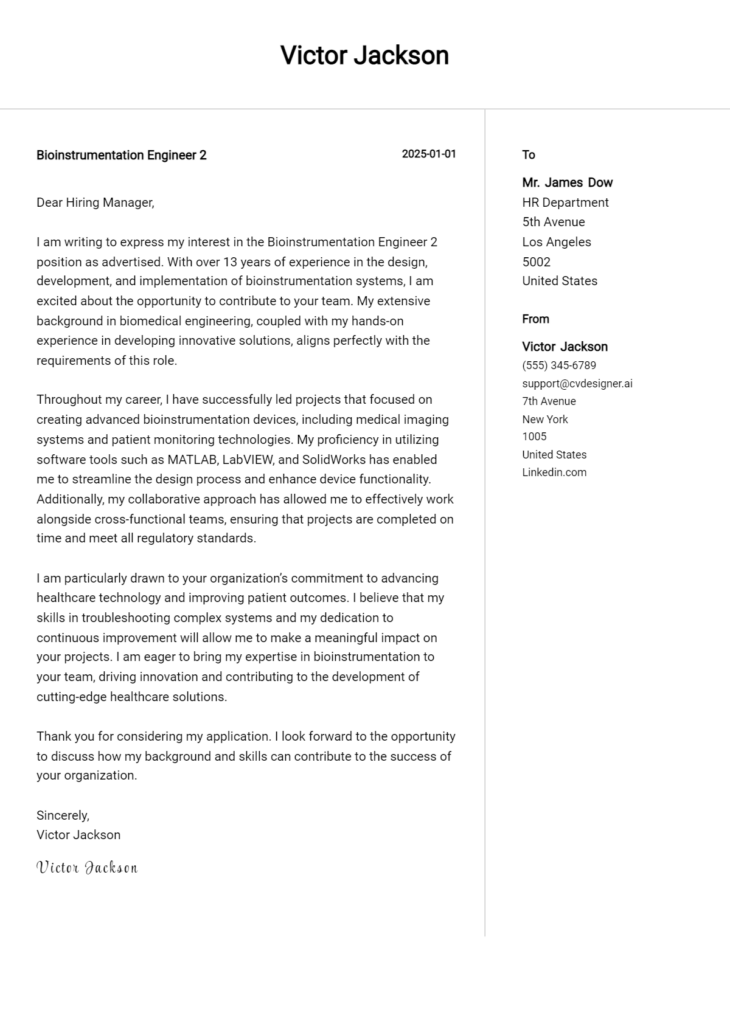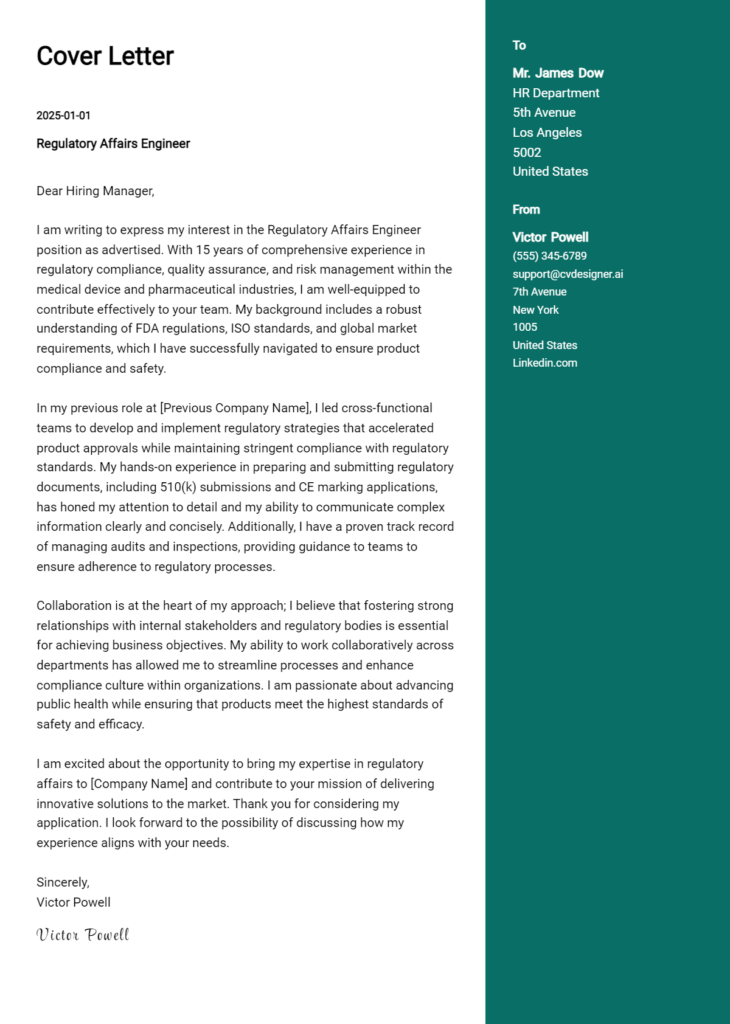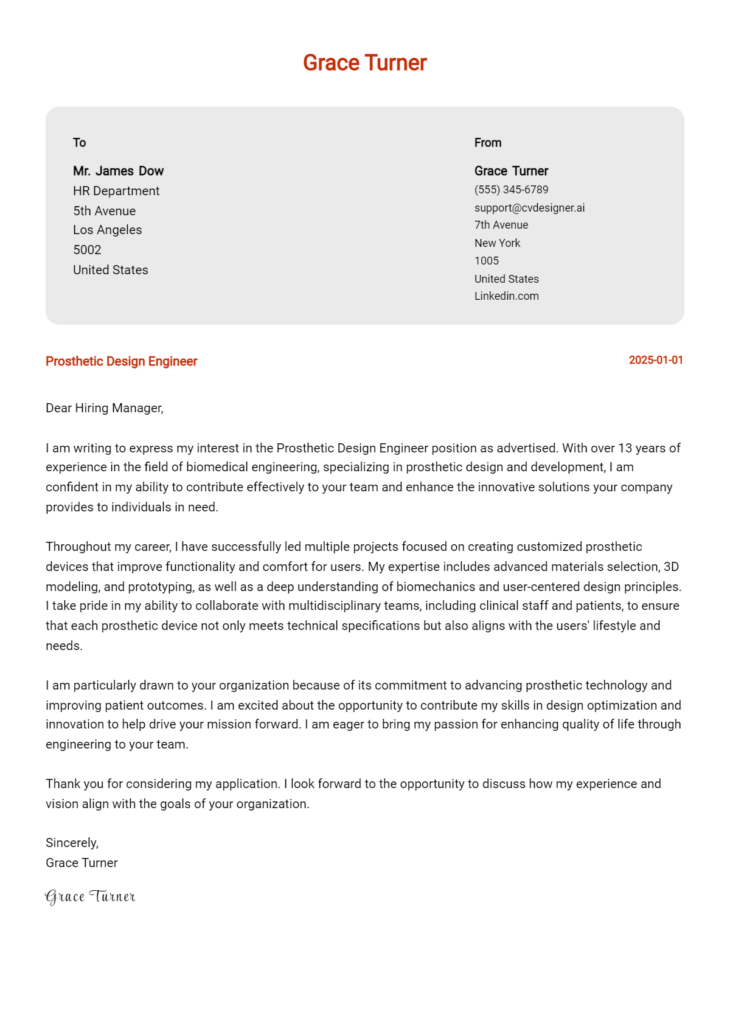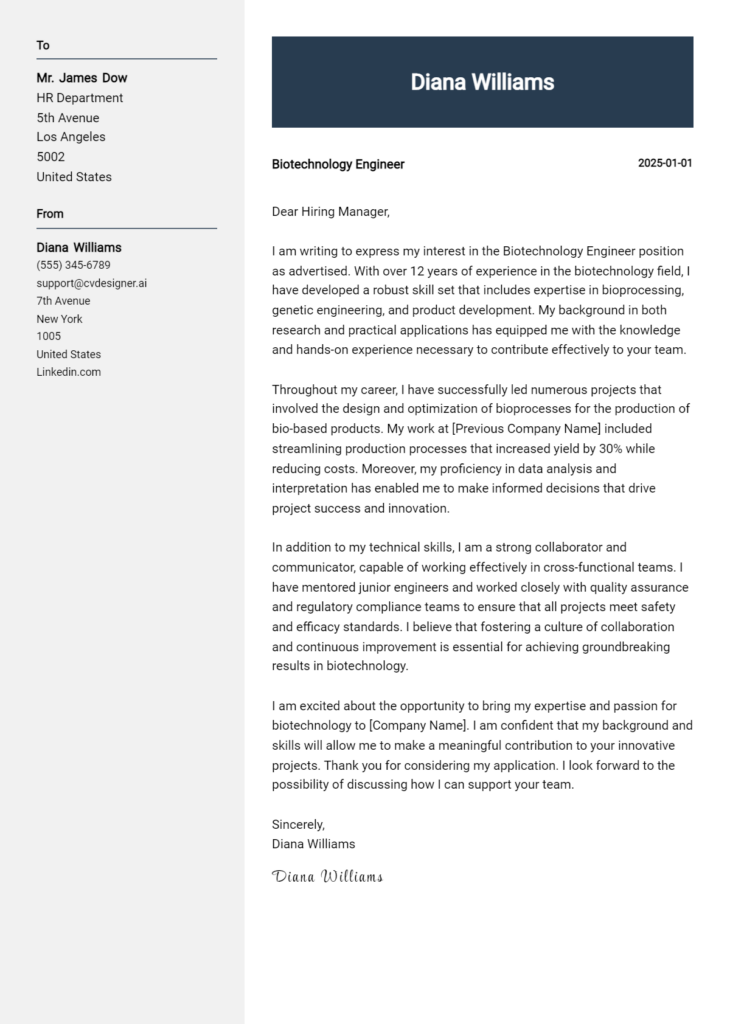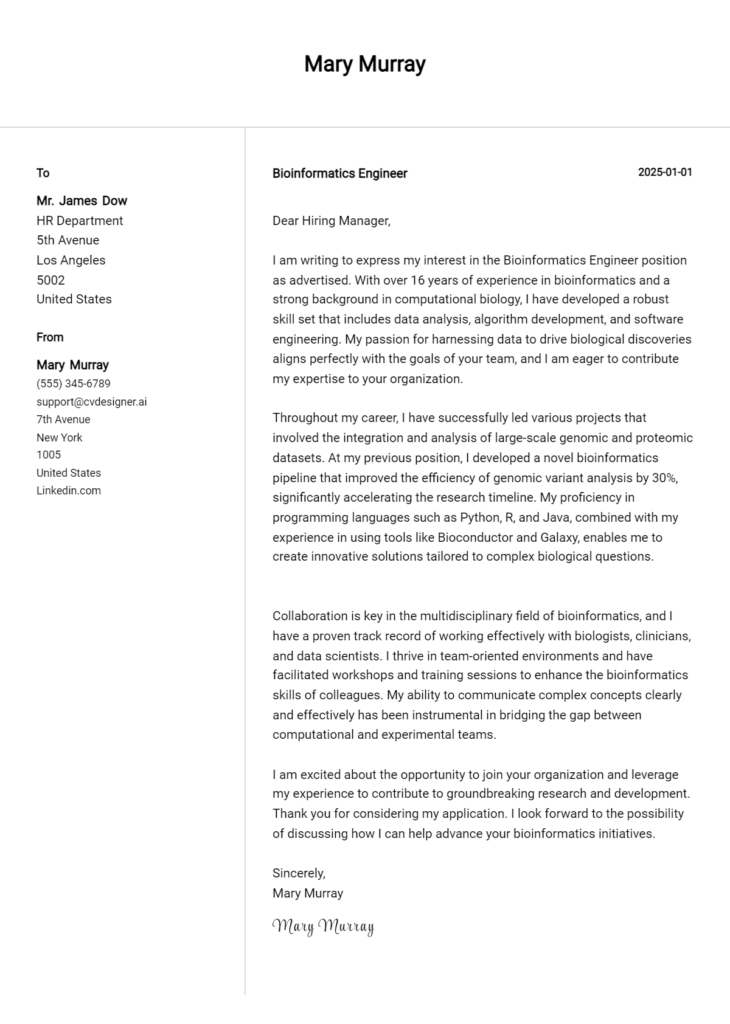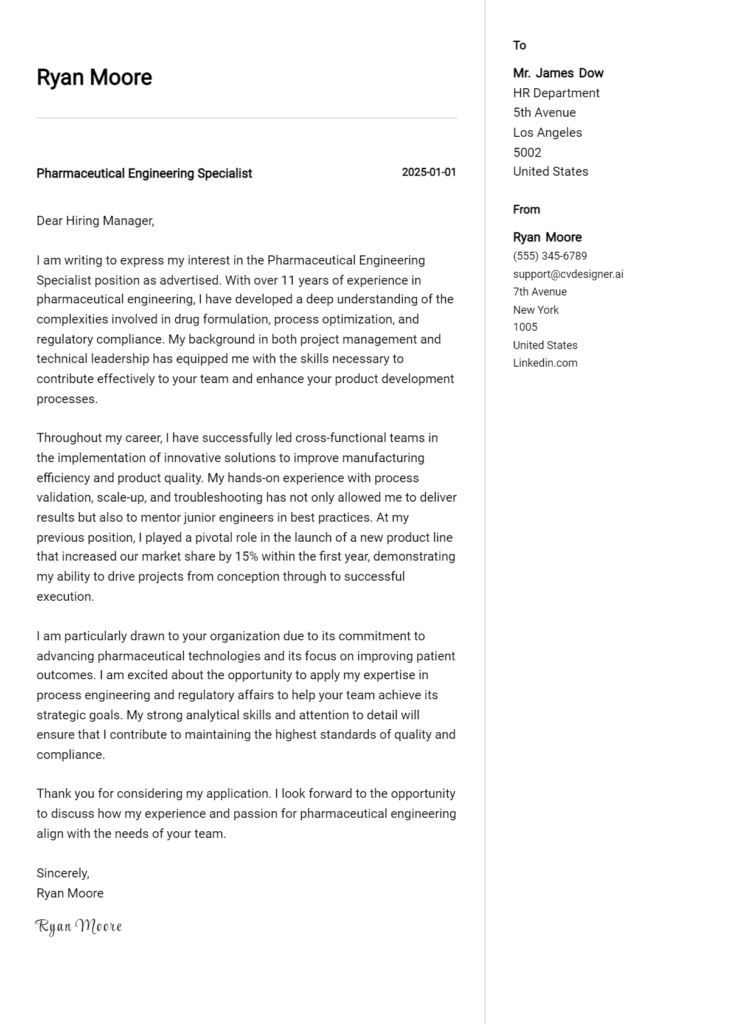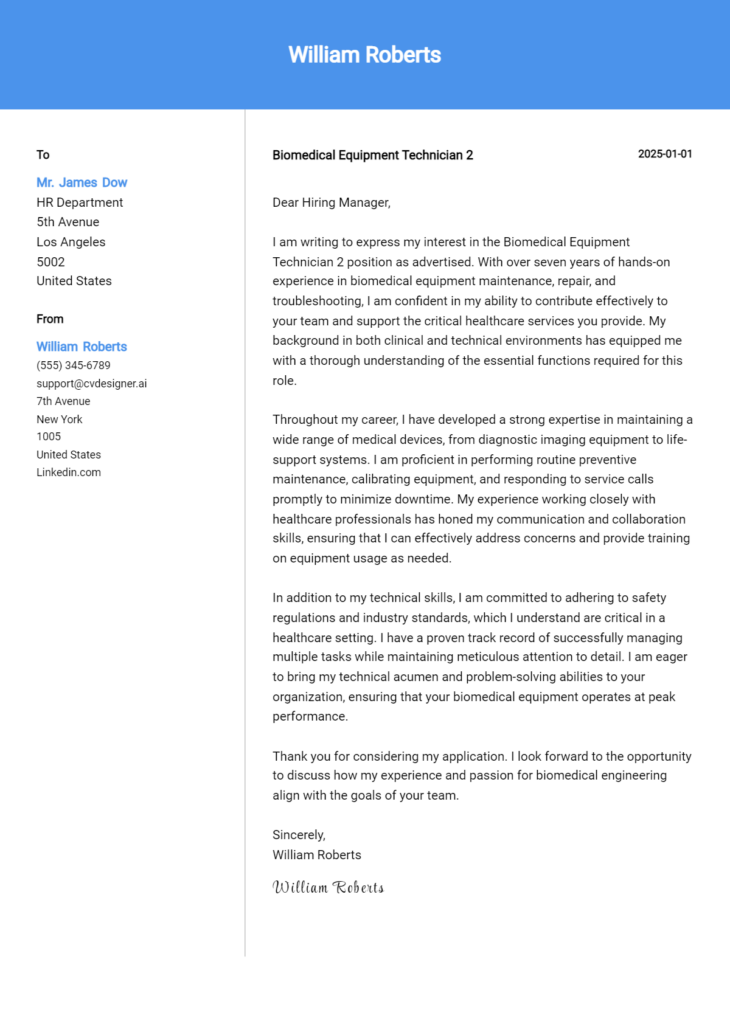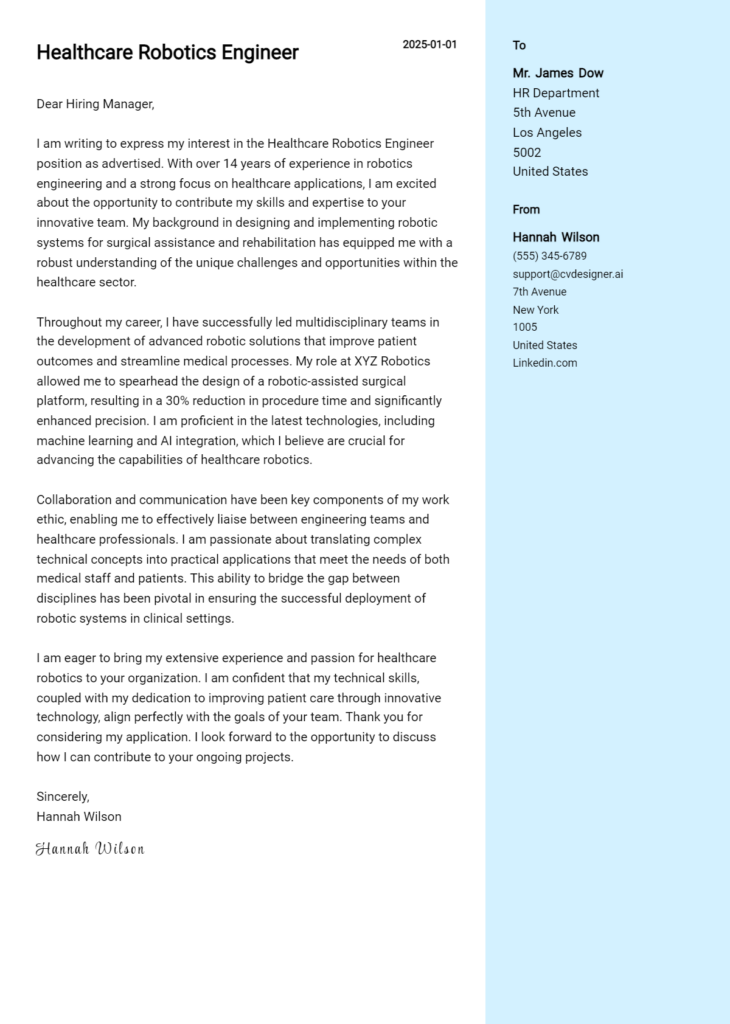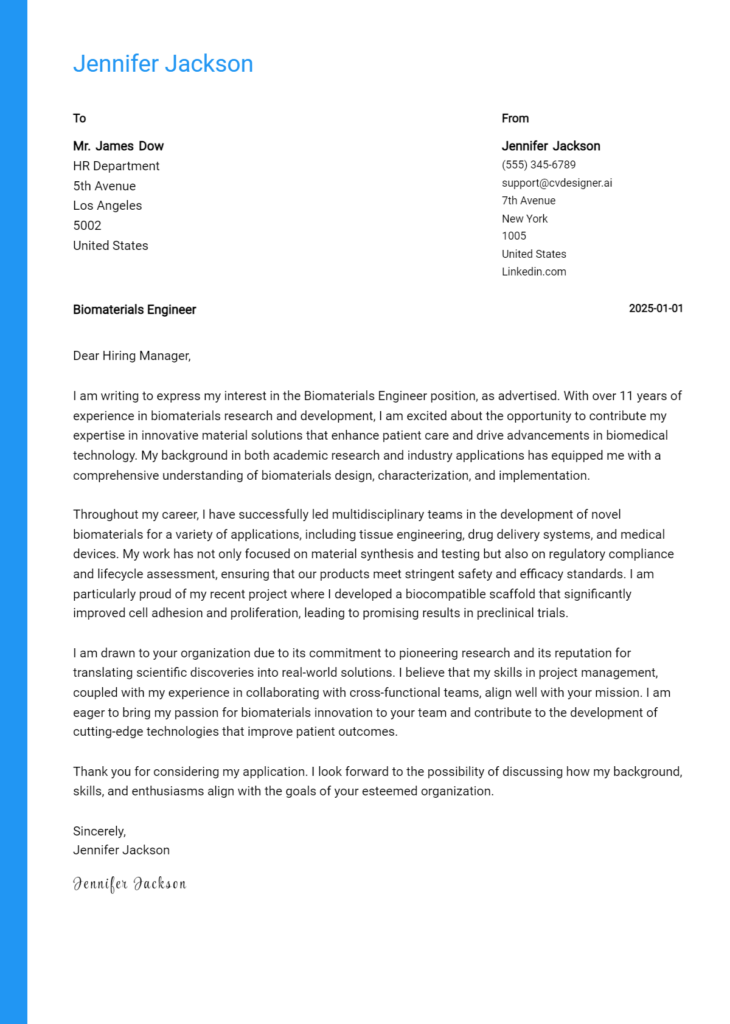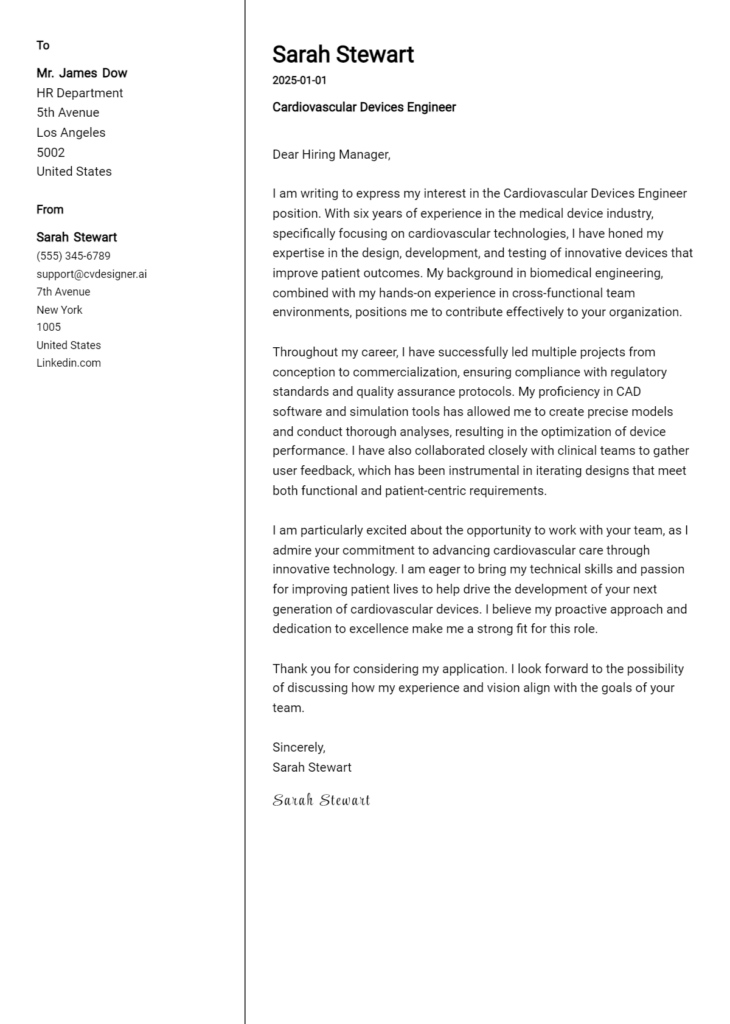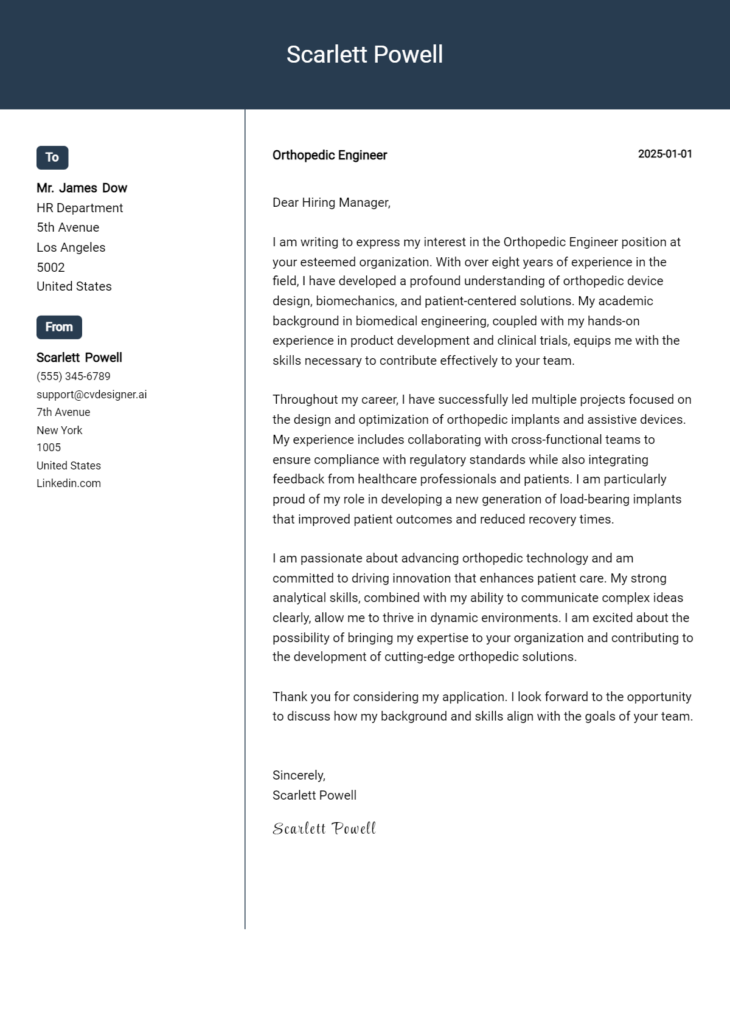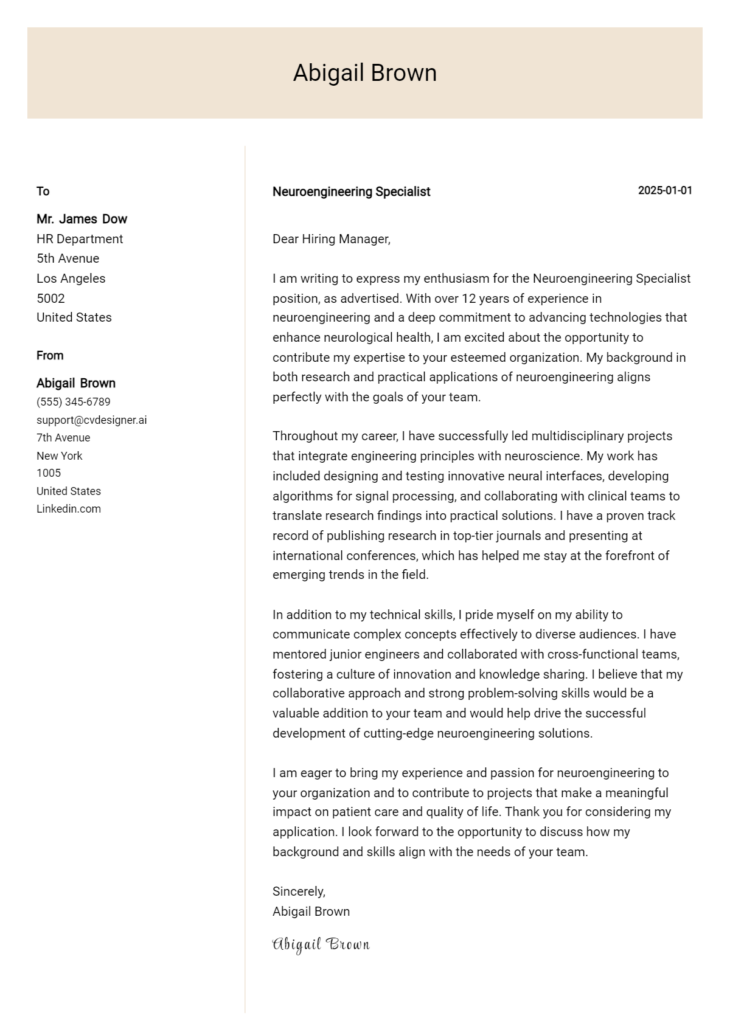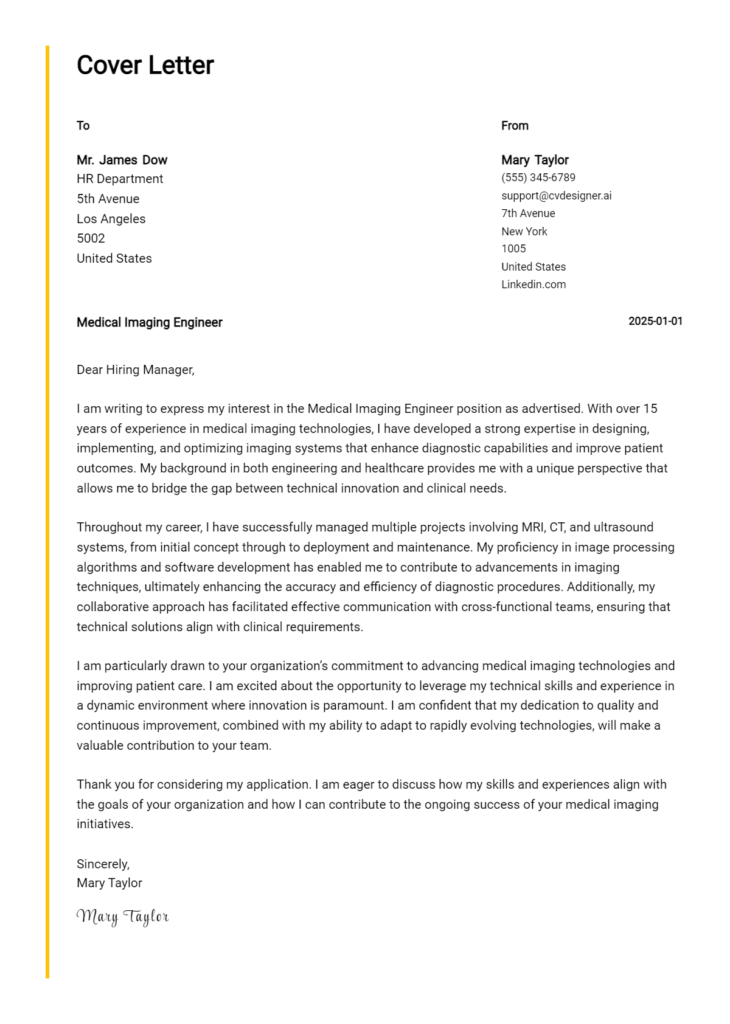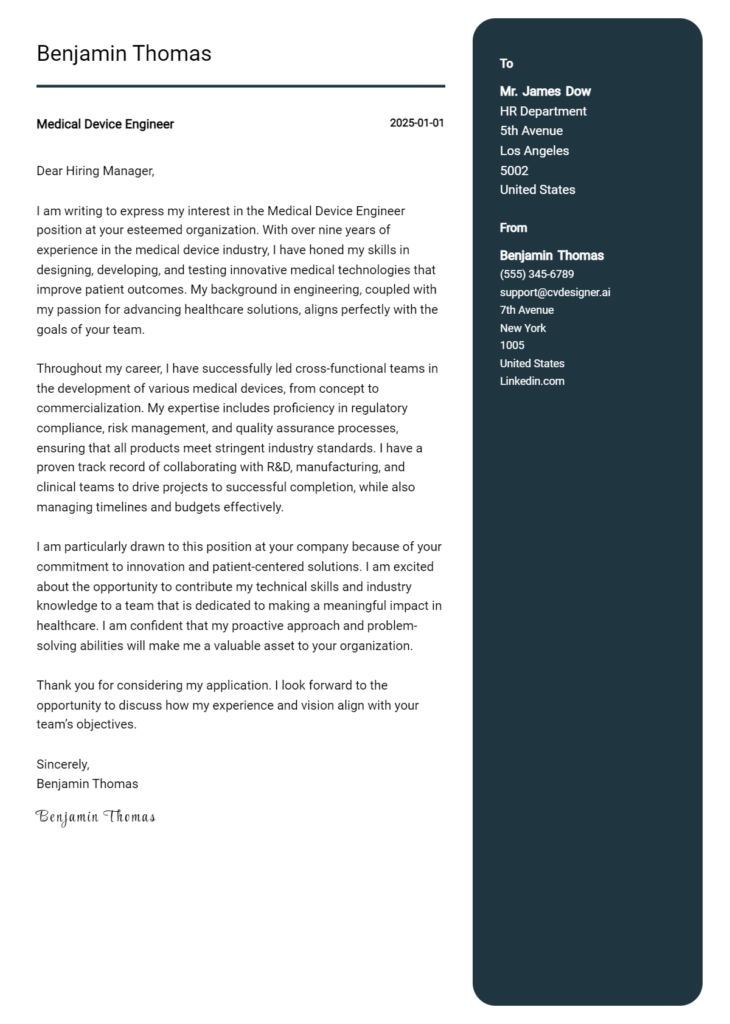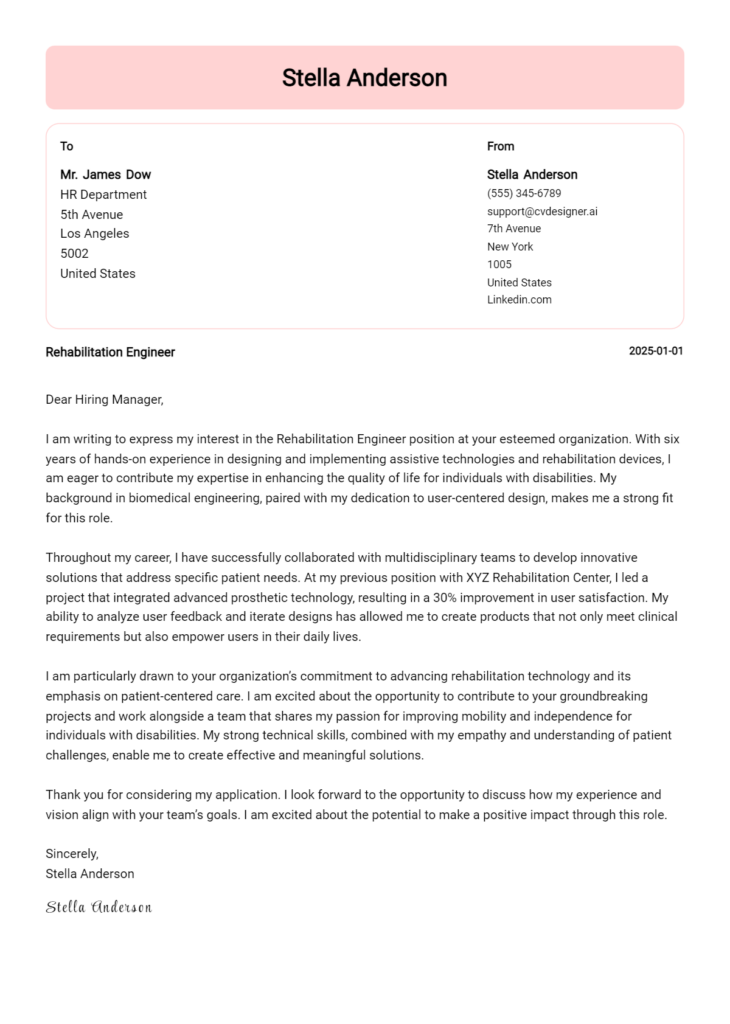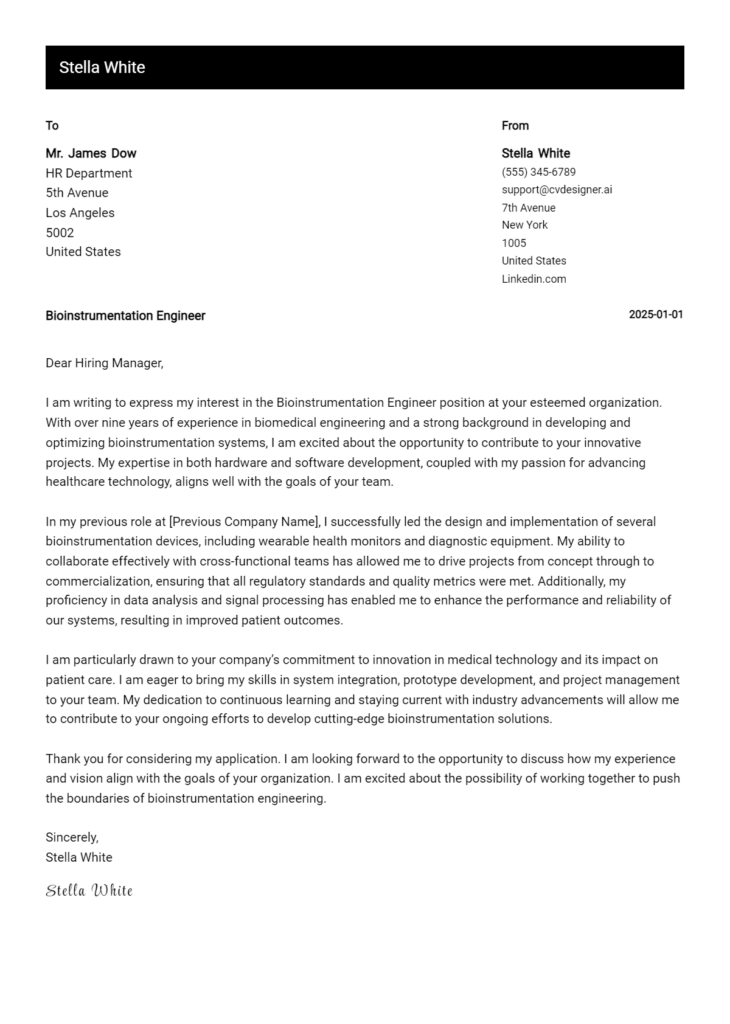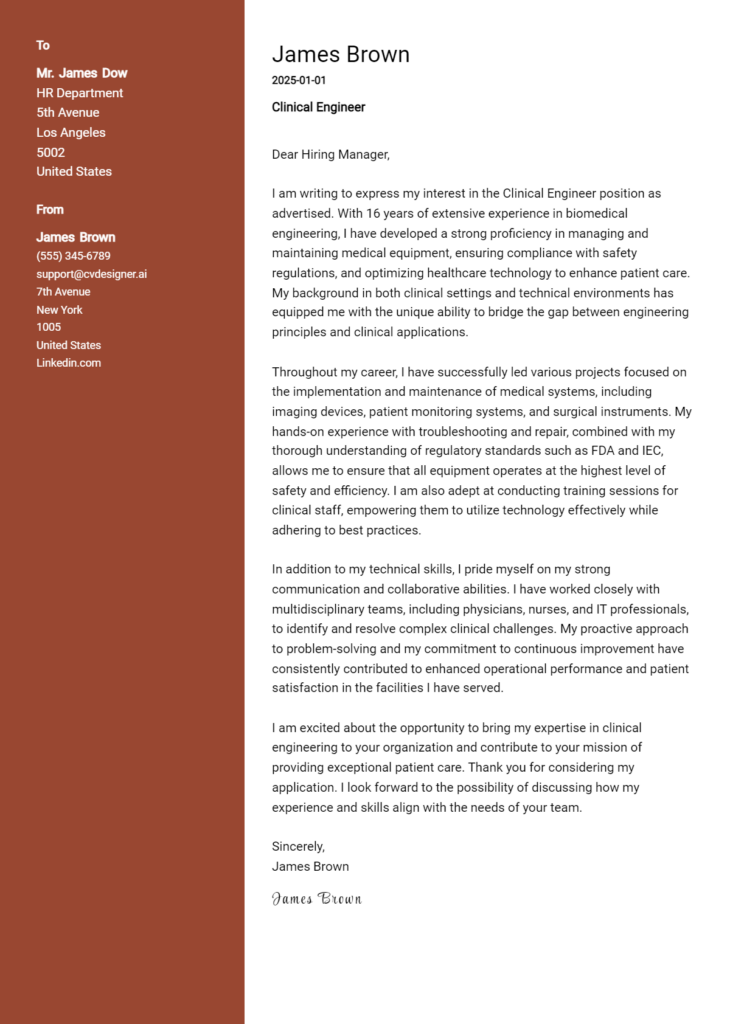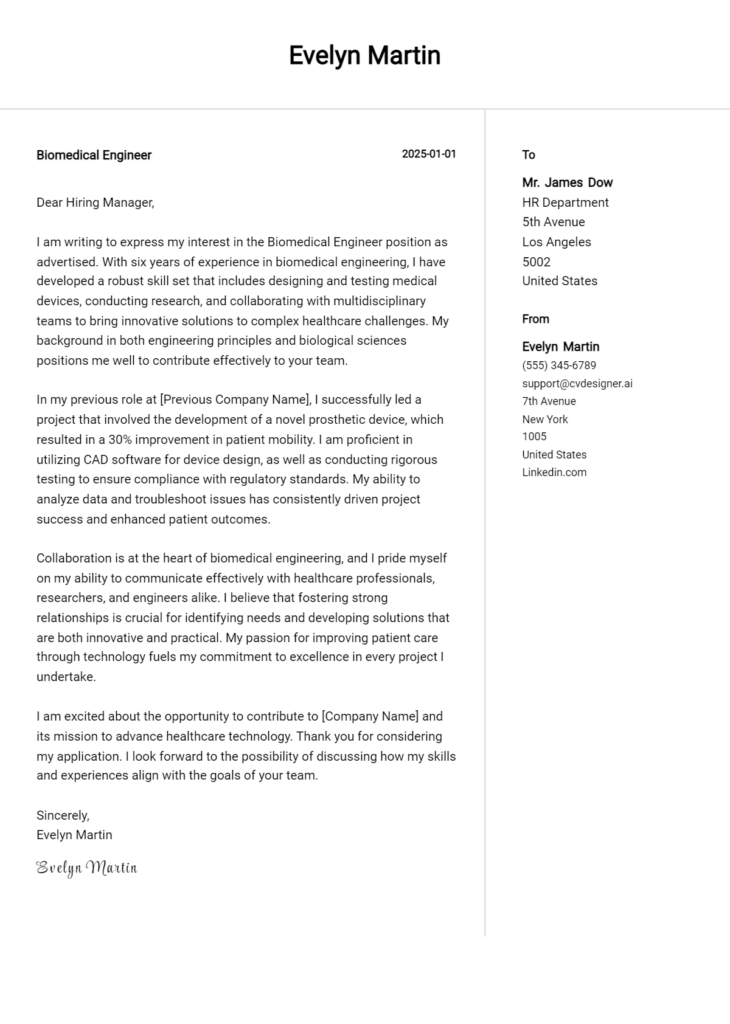Biomechanical Engineer Cover Letter Examples
Explore additional Biomechanical Engineer cover letter samples and guides and see what works for your level of experience or role.
How to Format a Biomechanical Engineer Cover Letter?
Crafting a compelling cover letter is essential for a Biomechanical Engineer, as it serves as your first opportunity to demonstrate your technical expertise and innovative thinking. The way you format your cover letter reflects your ability to communicate complex ideas clearly and effectively—a vital skill in engineering. A well-structured cover letter not only captures the hiring manager's attention but also showcases your problem-solving abilities and attention to detail, both of which are critical in the field of biomechanics.
In this guide, we will outline the key components of a professional cover letter, including:
- Cover Letter Header
- Cover Letter Greeting
- Cover Letter Introduction
- Cover Letter Body
- Cover Letter Closing
Each section is crucial in presenting your qualifications and professionalism. Let’s delve into each part to help you create a standout cover letter that highlights your strengths as a Biomechanical Engineer.
Importance of the Cover Letter Header for a Biomechanical Engineer
The cover letter header serves as the first impression to potential employers, making it a crucial element for any Biomechanical Engineer. A well-structured header not only provides essential contact information but also sets the tone for professionalism and clarity in your application. It should include your name, address, phone number, email, the date, and the recipient's details (name, title, company, and address). A clear and professional header ensures that the employer can easily reach you and gives your application an organized appearance.
Strong Example
John Doe 123 Engineering Lane Cityville, ST 12345 (123) 456-7890 johndoe@email.com October 15, 2023 Dr. Jane Smith Head of Recruitment Biomech Innovations 456 Tech Blvd Cityville, ST 12345
Weak Example
Hey there, My name is John, and I’m applying for the Biomechanical Engineer position! 10/15/23 Biomech Innovations
The Importance of a Cover Letter Greeting for a Biomechanical Engineer
The greeting of your cover letter serves as the first impression you make on potential employers, setting the tone for the rest of your application. A well-crafted greeting not only demonstrates professionalism but also shows your effort in personalizing the letter by addressing the hiring manager directly. This approach can help establish a connection and indicate your genuine interest in the position. To avoid generic greetings that can make your letter feel impersonal, take the time to research the recipient’s name and title. If you can't find the name, consider using a more specific greeting than "To Whom It May Concern."
Here are examples of strong and weak greetings to help guide you:
Strong Greeting Example
Dear Dr. Smith,
Weak Greeting Example
To Whom It May Concern,
The Importance of a Strong Cover Letter Introduction for a Biomechanical Engineer
A well-crafted cover letter introduction is crucial for a Biomechanical Engineer as it sets the tone for the entire application. In a field that merges engineering principles with biological systems, the introduction should not only capture the hiring manager's attention but also express genuine enthusiasm for the role. It’s an opportunity for the candidate to succinctly highlight their relevant skills, achievements, and experiences that align with the position. A compelling introduction can differentiate a candidate in a competitive job market, making it essential to get it right.
Strong Example
Dear [Hiring Manager's Name], I am excited to apply for the Biomechanical Engineer position at [Company Name]. With a Master's degree in Biomedical Engineering and over five years of experience developing innovative prosthetic devices, I am eager to contribute my expertise in biomechanics and material science to your team. My recent project, which improved the functionality of upper limb prosthetics and increased user satisfaction by 30%, showcases my ability to blend technical knowledge with user-centered design. I am passionate about advancing healthcare technology and am drawn to [Company Name]’s commitment to innovation and excellence.
Weak Example
To Whom It May Concern, I am writing to apply for the Biomechanical Engineer position. I have some experience in engineering and think I could do well in this role. I have worked on various projects but I’m not sure if they relate directly to this job. I hope you consider my application.
Purpose of the Cover Letter Body for a Biomechanical Engineer
The body of a cover letter for a Biomechanical Engineer serves as a vital opportunity to articulate the candidate’s relevant skills, experiences, and the unique value they can bring to the company. This section should highlight specific projects or accomplishments that demonstrate technical expertise and problem-solving abilities in the field of biomechanics. Candidates should aim to connect their past experiences with the job requirements and the organization's goals, showcasing how they can contribute to innovative solutions in product design, rehabilitation technology, or research. By effectively communicating these elements, the candidate can create a compelling case for their candidacy, making it clear why they are the best fit for the position.
Strong Example
Dear Hiring Manager, I am excited to apply for the Biomechanical Engineer position at XYZ Corporation. In my previous role at ABC Solutions, I led a team in the development of a pioneering prosthetic limb that utilized advanced sensor technology to enhance user feedback. This project not only improved the functionality of the prosthetic by 30%, but also garnered a national award for innovation in biomedical engineering. My experience in finite element analysis and my proficiency with CAD software allowed me to streamline the design process, reducing project time by 20%. I am eager to bring my skills in biomechanics and passion for improving patient outcomes to the innovative team at XYZ Corporation. Sincerely, [Your Name]
Weak Example
Dear Hiring Manager, I am interested in the Biomechanical Engineer position. I have a degree in biomedical engineering and have worked on several projects. I think I would be a good fit for your company because I have some skills that I learned in school. I hope to bring my knowledge to your team and work on interesting projects. Thank you, [Your Name]
Importance of the Cover Letter Closing for a Biomechanical Engineer
The closing paragraph of a cover letter is crucial as it serves to summarize the candidate's qualifications, reiterate their enthusiasm for the position, and encourage the hiring manager to take the next step. For a Biomechanical Engineer, this means emphasizing relevant skills and experiences that align with the job description, expressing a genuine interest in contributing to the team, and prompting the reviewer to look at the resume or arrange an interview. A strong closing can leave a lasting impression, while a weak one may fail to convey the candidate's eagerness or qualifications effectively.
Strong Example
Thank you for considering my application for the Biomechanical Engineer position at [Company Name]. With a solid foundation in biomechanics and hands-on experience in designing orthopedic devices, I am excited about the opportunity to contribute to your innovative projects. I am eager to discuss how my skills align with your team's goals and would welcome the chance for an interview. Please find my resume attached for further details, and I look forward to the possibility of working together.
Weak Example
I hope you look at my resume. I think I might be a good fit for the job. Let me know if you want to talk.
These tips will assist candidates in crafting an effective cover letter for a Biomechanical Engineer position. A well-structured cover letter is crucial as it serves as your first impression to potential employers. It's essential to highlight your technical skills, problem-solving abilities, knowledge of the Software Development Life Cycle (SDLC), teamwork experience, and a passion for continuous learning. By showcasing these qualities, you can demonstrate your value as a candidate who is not only capable but also eager to contribute to innovative projects.
Tips for Writing a Cover Letter for Biomechanical Engineer Positions
Highlight Technical Skills
Clearly outline your technical skills relevant to biomechanical engineering, such as proficiency in CAD software, Finite Element Analysis (FEA), or familiarity with biomechanical testing methods. Use specific examples and quantify your achievements where possible. This will demonstrate your expertise and ability to contribute to the technical demands of the role.Demonstrate Problem-Solving Abilities
Employers value engineers who can tackle complex challenges. Share an example of a problem you faced in a previous project and explain how you approached it, the tools and methods you used, and the successful outcome. This not only showcases your problem-solving skills but also your critical thinking and analytical abilities.Showcase SDLC Knowledge
If you have experience with the Software Development Life Cycle, mention it in your cover letter. Discuss your familiarity with each phase, from requirements gathering to testing and deployment. This knowledge can set you apart from other candidates, especially if the role involves software integration within biomechanical devices.Emphasize Teamwork and Collaboration
Biomechanical engineering often involves working with multidisciplinary teams. Highlight your experience collaborating with other engineers, medical professionals, or researchers. Describe a specific project where teamwork led to a successful outcome, focusing on your role and contributions to the collective effort.Express Passion for Continuous Learning
The field of biomechanical engineering is constantly evolving, and employers appreciate candidates who are committed to lifelong learning. Mention any certifications, workshops, or courses you have taken to enhance your skills. This demonstrates your proactive approach to professional development and your enthusiasm for staying updated with industry trends.
By following these tips and utilizing resources like cover letter templates and a cover letter builder, you can create a compelling cover letter that effectively showcases your qualifications and passion for the field of biomechanical engineering.
Common Mistakes to Avoid in a Biomechanical Engineer Cover Letter
Avoiding common mistakes in a cover letter is crucial for standing out as a Biomechanical Engineer candidate. A well-crafted cover letter can significantly enhance your chances of landing an interview. Here are some common pitfalls to watch out for:
Generic Formatting: Using a one-size-fits-all format can make your cover letter look unprofessional. Instead, follow a specific cover letter format that highlights your qualifications effectively.
Lack of Customization: Failing to tailor your cover letter to the job description can signal disinterest. Always research the company and mention how your skills align with their needs.
Overly Technical Language: While you want to showcase your expertise, using excessive jargon can alienate readers. Aim for clarity and balance between technical terms and layman’s language.
Neglecting Achievements: Simply listing duties from previous roles can make your letter bland. Instead, focus on quantifiable achievements that demonstrate your impact in past positions.
Spelling and Grammar Errors: Typos can undermine your professionalism. Always proofread your cover letter or use tools to check for errors before submission.
Being Too Lengthy: A cover letter should be concise and to the point. Aim for a one-page letter that clearly communicates your qualifications without unnecessary fluff.
Missing a Call to Action: Failing to express your enthusiasm for the position or not including a call to action can leave a weak impression. Close your letter by inviting the employer to discuss your application further.
By being mindful of these mistakes, you can create a compelling cover letter that will capture the attention of hiring managers. For inspiration, check out various cover letter examples to help you craft a standout application.
Cover Letter FAQs for Biomechanical Engineer
What should I include in my cover letter as a Biomechanical Engineer?
In your cover letter, highlight your educational background in biomechanics or a related field, emphasizing any relevant coursework or projects. Discuss your technical skills, such as proficiency in CAD software, finite element analysis, or programming languages like MATLAB. Include specific examples of your previous experience, such as internships or research projects, that demonstrate your ability to solve real-world biomechanical problems. Additionally, express your passion for the field and your desire to contribute to the company's mission. Tailor your letter to the specific job, mentioning any particular technologies or methodologies the employer values.
How can I demonstrate my qualifications effectively?
To demonstrate your qualifications effectively, use concrete examples that showcase your skills and experiences. For instance, explain how you applied your knowledge of biomechanics to design a prosthetic limb or improve an existing medical device. Quantify your achievements when possible, such as mentioning the percentage improvement in efficiency or patient comfort due to your design. Incorporate keywords from the job description to align your expertise with the employer's needs. Lastly, maintain a confident tone throughout your cover letter, ensuring that your passion for biomechanics and your commitment to advancing the field are evident.
How do I address gaps in my experience?
If there are gaps in your experience, focus on the skills and knowledge you've gained during that time. You might have pursued further education, completed relevant online courses, or engaged in self-directed projects. Be honest about your gaps but frame them positively, emphasizing your proactive approach to learning and professional development. Additionally, highlight transferable skills gained from any unrelated work or volunteer experiences, such as teamwork, project management, or communication. This approach shows potential employers that you are continuously striving to improve and that you bring valuable skills, even if they are not directly from a traditional biomechanical engineering role.
How should I format my cover letter?
For your cover letter, maintain a professional format that enhances readability. Start with your contact information at the top, followed by the date and the employer's contact information. Use a formal salutation, addressing the hiring manager by name if possible. Structure your letter into clear paragraphs: an introduction that grabs attention, a body that outlines your qualifications and experiences, and a conclusion that expresses enthusiasm for the position. Use a standard font like Times New Roman or Arial, size 10-12, and keep the letter to one page. Ensure proper spacing and margins for a clean, professional appearance.
Build your Cover Letter in minutes
Use an AI-powered cover letter builder and have your letter done in 5 minutes. Just select your template and our software will guide you through the process.

